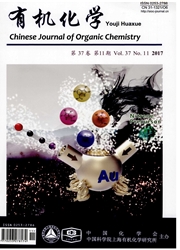

 中文摘要:
中文摘要:
硅亚胺作为亚胺的重元素类似物,是一类重要的含硅多重键化合物.本研究首次报道了氮杂环卡宾诱导下二胺基氯硅烷脱除Me3Si Cl来制备硅亚胺的方法.合成了二胺基氯硅烷[Ar N(Si Me_3)]_2SiHCl(2)(Ar=2,6-i-Pr_2C_6H_3),通过^1H NMR,^(13)C NMR,^(29)Si NMR,红外以及元素分析的表征确定了2的结构.研究了2与不同位阻氮杂环卡宾的反应性,发现其与位阻较大的1,3-二叔丁基咪唑-2-亚基(It Bu)和1,3-二异丙基-4,5-二甲基咪唑-2-亚基(Ii Pr)均不反应,但是其与位阻较小的1,3,4,5-四甲基咪唑-2-亚基(IMe_4)反应生成氢化硅亚胺3.
 英文摘要:
英文摘要:
Studies on the formation of silaimines are among the most fascinating topics in organosilicon chemistry. The first route to silaimine via eliminaition of Me_3 SiCl from diaminochlorosilanes is reported. Reaction of aminodichlorosilane Ar N(SiMe_3)SiHCl_2(1)(Ar=2,6-i-Pr_2C_6H_3) with ArN(SiMe_3)Li in Et_2O at-78 ℃ followed by stirring the mixture for 5 h at room temperature afforded diaminochlorosilane [Ar N(Si Me_3)]_2SiHCl(2). Compound 2 has been fully characterized by ~1H NMR, ~(13)C NMR, ~(29)Si NMR, IR and elemental analysis. Reactivity of 2 with different N-heterocyclic carbenes has been examined. It was found that 2 did not react with sterically hindered N-heterocyclic carbenes(NHC), 3-tert-butylimidazol-2-ylidene(It Bu) and 1,3-diisopropyl-4,5-dimethyl-imidazol-2-ylidene(IiPr) at room temperature or under reflux conditions. However, compound 2 could react with one equivalent of 1,3,4,5-tetramethyl-imidazol-2-ylidene(IMe_4) to give base-stabilized 1-hydrosilaimine 3. Compound 3 can be viewed as the elimination product from 2 through loss of Me3SiCl, as the small IMe_4 coordinate to 2 to form a hypervalent silicon species.
 同期刊论文项目
同期刊论文项目
 同项目期刊论文
同项目期刊论文
 期刊信息
期刊信息
